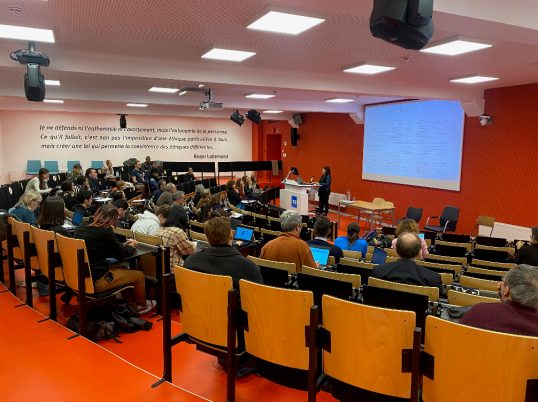
On 29 and 30 September 2022, the School of Translation and Interpreting (ETI) of the Université Libre de Bruxelles organised a conference to mark its move to the Solbosch university campus and the launch of its new course programme. The conference was entitled “Teaching translation and interpreting in the neural age”. It was jointly organised by the ULB’s School of Translation and Interpreting (ETI) and its research centre Tradital, the Translation Studies and Corpus Linguistics Department of the University of Mons and was sponsored by the Faculty of Letters, Translation and Communication (LTC), the Faculty of Translation and Interpretation (FTI-EII), the FNRS, the European Commission and the EMT.
Neural machine translation (NMT), has made irreversible inroads in the field of translation and translation studies and naturally also impacts the training of future translators and interpreters. The age of Big Data and corpus-based methods has ushered in the datafication of translation. As a developing AI technology, NMT is at the centre of exciting and promising research. The impact it has on the translation industry must inevitably also filter through in training programmes.
The papers that were presented at the conference, reflected on the various ways NMT is transforming the translation industry and training programmes. The question of how developments in NMT will affect professional interpreters and interpreter trainers was also raised. While some speakers focused their analysis on the translation product (e.g. quality assessment, post-edition, price-setting, comparing systems, defining the role of the human translator, etc.), other speakers zoomed in on the translation process (e.g. deviations in algorithm output, performance or impact).
Various speakers and participants brought up a number of interesting questions and observations:
-
In addition to translation and revision, translation trainers now also teach their students post-editing techniques. At what stage though should machine translation and post-editing be integrated in the curriculum? At the bachelor or master level? Should it be included in life-long learning programmes for professionals and trainers? Should it be taught as a separate course module or should it be integrated in all translation classes? Should it be taught only in the context of translation into the mother tongue or also in the context of translation into a foreign language?
-
A number of experts emphasized that while it is important to train students’ post-editing skills, they must also be taught how machine translation works. In order to keep pace with all the technological innovations, the world of translation - and even the world at large - needs to invest more in promoting "machine translation literacy". This realisation in turn raises other questions, for example about the content of more traditional CAT courses and the use of translation tools such as translation memories or terminology databases.
-
The digitalisation of the profession not only requires us to rethink the way we teach translation but also our approach to L1 and L2 teaching. Doing research and sharing best practices will help to steer translation training in the right direction.
-
The technological turn in interpreting has not yet left a clear and lasting mark on the professional day-to-day activities of interpreters. While a new hybrid form of interpreting called "simconsec", involving the use of recorded speech in consecutive interpreting, has emerged, it has not (yet) become commonplace. Direct simultaneous speech-to-text translation assisted by NMT is another interesting new lead that needs further exploration. Have these innovations gained enough ground to integrate them in interpreter training? And what would be the best way to go about it?
Recent technological advances, and NMT in particular, have brought about a paradigm shift. While the translation industry was quick to adopt the new practices, researchers are currently reflecting on the full implications of the technological turn. The vast number of newly coined acronyms to denote new techniques and processes is a credit to the potential of these innovations. Despite all this, there is also some degree of hesitation to fully embrace them as there remain a lot of unanswered questions about, for example, the ethical implications and the exploitation of personal data.
Scientific research can help to pave the way forward. The papers presented at the conference all gave clear indications on what the future of translation and translator training could look like. The translator of course must always play a key role in the process. Although the technological turn has already made an indelible mark, there is a common consensus among practitioners, researchers and trainers that human intervention in the translation process will remain crucial in the foreseeable future. In all likelihood, the industry will need people who are well-versed in machine translation and at the same time master revision and post-editing techniques.
Historically, the study of translation has only recently gained recognition as a fully-fledged scientific discipline and today still often operates in unchartered territory. The conference has shed light on a wide array of theoretical, methodological and pedagogical aspects of NMT that are of interest to both researchers and practitioners. Its practical applications have been shown to be both fascinating and promising.
The conference provided a platform for reflection which will hopefully inspire new insights and will spark further discussions in the EMT community and beyond.
Details
- Publication date
- 21 November 2022
- Language
- English
- French
- Dutch
- EMT Category
- Pedagogical initiatives
- Translation competences
- Translation technology

